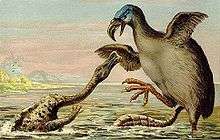Brontornis
| Brontornis Temporal range: Miocene | |
|---|---|
| | |
| Restoration | |
| Scientific classification | |
| Kingdom: | Animalia |
| Phylum: | Chordata |
| Class: | Aves |
| Order: | Cariamiformes |
| Family: | †Phorusrhacidae |
| Subfamily: | †Phorusrhacinae |
| Genus: | †Brontornis Moreno & Mercerat, 1891 |
| Species: | †B. burmeisteri |
| Binomial name | |
| Brontornis burmeisteri Moreno & Mercerat, 1891 | |
| Synonyms | |
| |
Brontornis was a genus of giant flightless predatory birds that lived in Patagonia.[1][2][3][4][5][6] The only species currently accepted as valid is B. burmeisteri. It has traditionally been placed in the family Phorusrhacidae, nicknamed "terror birds" for their large size and predatory lifestyle, more specifically the subfamily Brontornithinae, which contains the extremely large and heavy-set phorusrhacids.
Description
It is known from bones, mainly of the legs and feet but also portions of some skulls and backbone, found in several localities of Santa Cruz Province.
B. burmeisteri was the second tallest species of phorusrhacid, with a height of around 2.8 m (9.2 ft) and the heaviest species of phorusrhacid with an estimated weight of 350–400 kg (770–880 lb) (Alvarenga & Höfling, 2003), making it the third-heaviest bird ever according to current knowledge (after Aepyornis maximus and Dromornis stirtoni), and the most massive land predator of its time and place. Due to its bulk, it probably had a lifestyle between an ambush predator and one that actively chased prey, pouncing on the latter from a hideout and bringing it down by sheer force of attack after a short chase. In attacking prey (but probably not necessarily in a defensive situation, as it was too slow-moving) it most likely was the dominant carnivore of Miocene Patagonia, being able to kill even large animals such as the elephant-like Astrapotherium and in the predatory role being on par with a pack of Thylacosmilus (metatherian sabre-tooth). It coexisted with some slightly smaller and more active phorusrhacids like Phorusrhacos, but apparently became extinct before the appearance of the immense Argentavis, the largest flying bird ever.
Classification
There are several synonyms of the species and genus:
Possibly, the fossils described as B. platyonyx represent another species; they are about one-third smaller than the largest Brontornis bones. It is much more likely, however, that they represent sexual dimorphism. In today's hawks and owls, females are usually considerably larger than the males; this prevents overutilization of one size class of prey. It is not known whether phorusrhacid males or females would have been larger, but the fossils of the North American phorusrhacid Titanis also show considerable variation in size, suggesting that there was indeed at least a tendency for differently sized sexes.

Recent work[7][8][9] has cast doubt on the hypothesis that Brontornis is a phorusrhacid. Brontornis may actually represent an anseriform, with other genera traditionally assigned to Brontornithinae (Physornis and Paraphysornis) being true phorusrhacids. The subfamily containing the latter two had been proposed to be renamed to Physornithinae, with Physornis fortis as the type. If these conclusions are valid, this would mean that there are three groups of giant basal anseriformes, in chronological order of divergence: the gastornithids (Gastornis and kin), Brontornis, and finally the mihirungs of Australia. However, other analyses have also argued that Brontornis exhibits thoracic vertebrae diagnostic of phorusrhacids, supporting its placement within that group.[10]
References
- ↑ Alvarenga, Herculano M. F. & Höfling, Elizabeth (2003): Systematic revision of the Phorusrhacidae (Aves: Ralliformes). Papéis Avulsos de Zoologia 43(4): 55-91 PDF fulltext
- ↑ Moreno, Francisco P. & Mercerat, A. (1891): Catálogo de los pájaros fósiles de la República Argentina conservados en el Museo de La Plata. Anales del Museo de La Plata 1: 7-71.
- ↑ http://darrennaish.blogspot.com/2006/10/terror-birds.html
- ↑ http://darrennaish.blogspot.com/2006/11/more-on-phorusrhacids-biggest-fastest.html
- ↑ http://dml.cmnh.org/2000Mar/msg00218.html
- ↑ http://dml.cmnh.org/2000Mar/msg00099.html
- ↑ 2007: a good year for terror birds and mega-ducks
- ↑ Agnolin, F. 2007. Brontornis burmeisteri Moreno & Mercerat, un Anseriformes (Aves) gigante del Mioceno Medio de Patagonia, Argentina. Revista del Museo Argentino de Ciencias Naturales, n.s. 9, 15-25
- ↑ Buffetaut, E. (2014). "Tertiary ground birds from Patagonia (Argentina) in the Tournouër collection of the Muséum National d'Histoire Naturelle, Paris". Bulletin de la Société Géologique de France. 185 (3). doi:10.2113/gssgfbull.185.3.207.
- ↑ Alvarenga, H.; Chiappe, L.; Bertelle, S. (2011-05-03). "Phorusrhacids: the Terror Birds". In Dyke, G.; Kaiser, G. Living Dinosaurs: The Evolutionary History of Modern Birds. Wiley. pp. 187–208. ISBN 978-0-470-65666-2. OCLC 664324132.